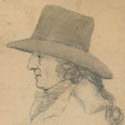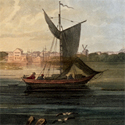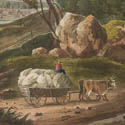Landscape View Books
By the time George Campbell retired in 1829, the number of new books published each year was soaring and the Library Company was struggling to meet the needs of an exploding industrial metropolis. In the meantime, partly because of his influence, there were a dozen or more substantial private collections of fine books in the city. Accordingly the new Librarian John Jay Smith immediately curtailed the importation of luxury editions and concentrated instead on harvesting the private collections, with striking success.
Smith’s first coup was the library of the eccentric artist James Cox, purchased in 1832 in return for an annuity of $400 a year. Cox died after only one payment had been made. His greatest coup was a promised bequest, the library of Dr. James Rush, including the books and papers of his more famous father Dr. Benjamin Rush. Rush died in 1869. Both collections were rich in color-plate books.
 [Joseph?] Wood. James Cox. Ink wash and pencil on paper, ca. 1813-1816. .
[Joseph?] Wood. James Cox. Ink wash and pencil on paper, ca. 1813-1816. .
Just one of the many collections J.J. Smith harvested was the library of the eccentric artist James Cox. In 1832 Smith arranged to purchase the entire collection for an annuity of $400. Cox obligingly died the next year, making his library an even greater bargain.
 Joshua Shaw and John Hill. Picturesque Views of American Scenery. Philadelphia: M. Carey, 1820. Purchased by annuity from James Cox, 1833.
Joshua Shaw and John Hill. Picturesque Views of American Scenery. Philadelphia: M. Carey, 1820. Purchased by annuity from James Cox, 1833.
Among the jewels of the Cox collection was a superbly hand-colored copy of this, the first American landscape view book. The 18 aquatints and the accompanying text argued that America’s natural beauties compared favorably with those of Europe. In a sense this was a landscape counterpart to Birch’s city views.
 William Guy Wall and John Hill. Hudson River Portfolio. New York: H.I. Megarey and W.B Gilley, 1821-1825. Bequest of James Rush, 1869.
William Guy Wall and John Hill. Hudson River Portfolio. New York: H.I. Megarey and W.B Gilley, 1821-1825. Bequest of James Rush, 1869.
New York ’s answer to Picturesque Views, the Hudson River Portfolio’s twenty plates inspired a whole school of landscape painters in oils. The New York book is better known; but the two books are actually quite similar, partly because the engraver John Hill worked on both books. Our copy of the Hudson River Portfolio came from another private collection, the 1869 bequest of James Rush, son of the famous Revolutionary-era physician. His copy included the only known copy of the prospectus for the project.